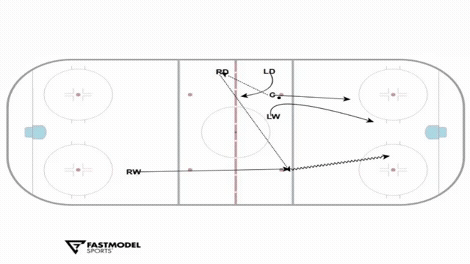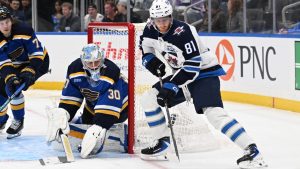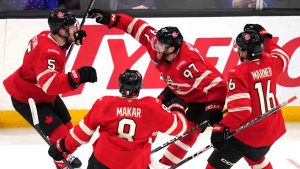With the launching of the Professional Women’s Hockey League this week, attention has been drawn to a couple ways in which they’ll differentiate themselves from the men’s game regarding rules. Points to the new league for really going off the board by offering penalty killers the chance to negate the opposing power play by scoring a shorthanded goal.
I like the idea of a team having such dangerous penalty killers that they can be more aggressive at 5-on-5 (since they’d be less afraid to go on the kill), I like the idea of PKers taking risks that would open up more power play scoring opportunities as well, and I like the idea of getting back to 5-on-5 hockey more regularly. While I do believe penalties should indeed penalize a team (otherwise we’ll encourage more hooking and holding), having more ways to end the slower special teams play to get back to evens is simply a positive thing.
This led to a chat exchange between Andrew Brewer and myself, in which we kicked around a few ideas, one of which we're going to share with you today. A few of the others -- such as eliminating neutral zone faceoffs entirely -- will wait for another day.
Brewer, as you may recall from our earlier collaboration, spent nearly a decade in the NHL as a video and assistant coach, won gold in those roles at the Olympics and World Championships and World Cup, and is currently the manager of Hockey Business Development at FastModel Technologies (they provide scouting, diagramming, and roster management tools for hockey coaches and management),
Without further ado...
Justin Bourne: Brew! Appreciate you taking the time to once again help me out. Today I wanna talk about the PHWL rules, get your thoughts, and then we can talk about what the NHL could change. Let's start here:
The PWHL implemented the 3-2-1-0 point system that everyone on earth agrees is better than what the NHL uses. I'm assuming I can put you in that group?
Andrew Brewer: Thanks for chatting Bourney!
What’s interesting about the PWHL is they get to start from scratch. No records to worry about, relevant history, you don’t have to worry about the 2023-24 Vegas Golden Knights breaking a record from a 1970s Canadiens team.
I love the three-point system, it’s the perfect way to distribute points when you want to avoid ties.
Bourne: Yeah, the common sentiment is the NHL standings look "closer" which keeps fans of lesser teams in it longer (so they say), but I think the ability to make up ground is so hard in the NHL we don't get as many great come-from-behind standings stories. Anyway, we agree here.
The new PWHL rule that fascinates me most is how a shorthanded goal kills an opponent's power play. I initially love the idea -- it incentivizes risk taking on the PK, which should create more offence both ways -- but I saw former Canucks AGM Chris Gear tweeting that he'd prefer to see people who take penalties do their time. What are your thoughts on that twist?
Brewer: I just love the fact that they are doing something different. I love and respect the history of the game; but I also love change.
I understand the philosophy of “you did the crime, you do the time,” but I also really like the rule change they played around with in their pre-season in Utica…they didn’t allow the team killing a penalty to ice the puck. This is a common rule in the USA Hockey rule book. The logical side of me never understood why you get a “privilege” to be able to ice the puck shorthanded.
Bourne: Yeah, it's funny, seeing Major League Baseball have success changing some of its rules (pitch clock, bigger bases, shift banning) made me feel like we don't have to be so protective of the NHL's rule book. In fact, it's interesting when historians provide context -- "these records happened before X rule change, so..."
I'll kick off what we're going to get into here by saying we both like offence and think it benefits the game and its fans. Which is to say, I like both the shorthanded goal killing the PP, and the idea of not icing the puck on the penalty kill.
So let's talk about the NHL, which is basically where I'm going to hand it off to you. What are some rule changes you'd like to see the league enact?
Brewer: Exactly. You can respect the history of the sport, but at the end of the day, professional sports are an entertainment product so it’s the league's job to keep entertainment in mind.
On that note, it’s on the coaches and teams to win hockey games, so although their input on rules matters I think leadership needs to come from the top on rule changes.
The first thing I would change in the NHL is faceoffs. Remember your dad taking faceoffs 25.7 inches inside the blue line back in the 1980’s?
Bourne: Yes, inside their own blue line. That was still around when I was playing as a kid I think.
There are a couple of low hanging things I think you could do to create more offence and add some excitement.
Brewer: It’s crazy when you watch old games, the refs looked like they just dropped the puck anywhere all over the ice!
The first thing I would change for faceoffs would be to eliminate neutral zone blue line faceoffs. This is one of the worst parts of hockey. Best case the offensive team wins the draw, they go D-to-D and they run the puck in.
Worst case the defensive team wins the puck, and a defenceman has it just inside their own blue line with five players standing between him and the net.
Nothing exciting happens after neutral zone blue line faceoffs.
Bourne: True. It's a stalemate or a dump-in.
Brewer: So get rid of them! You go offside, the puck goes back to your own end.
It incentivizes teams to not slow down play because the cost of a faceoff is higher, and it’s something that could be implemented with limited push back. The precedent is there, it would be an easy change.
Bourne: That's actually really, really good, and simple.
Brewer: And the math backs it up! Very little is created off neutral zone draws, and a ton happens off offensive zone faceoffs.
Bourne: I didn't mean to sound so surprised, but yeah, a big swing there in outcomes with a rush-for turning into a defensive zone faceoff.
Brewer: It’s a huge difference. The likelihood of giving up a scoring chance after a defensive zone faceoff is incredibly higher than giving up a chance after a neutral zone draw.
Bourne: Yeah, and you're a guy who drew up in-zone faceoff plays in the NHL, so you're certainly well aware of all the ways there are to create something from that position.
Brewer: I spent six years in the NHL being responsible for faceoffs. I watched over 400,000 faceoffs and if I never have to watch another blue line faceoff again I will die a happy man!
Bourne: Haha, ya, I imagine you've seen a few patterns develop then.
Brewer: While we’re on the topic, I also think it’s time to change the way faceoffs are conducted. This one I’m stealing from football.
I think you should be able to have “pre-snap movement” before the puck is dropped.
Bourne: This is the part of the conversation I'm most excited about, because surely there's actually something doable and awesome here.
I imagine if those neutral zone faceoffs were kept in the game, allowing pre-drop movement would make them a lot more exciting.
Brewer: It's a bit of a grey area if this one isn't already allowed in the rule book, but no one has given a clear answer. Some teams will kind of do this with slight motion now.
But let’s get guys moving in the backfield!
Bourne: That's a good place to go next: as far as you or I can tell, it doesn't seem to be illegal to move prior to the draw if you're something other than a centre. But I know for sure if a defenceman was winding up momentum from behind his net as the linesman was preparing to drop the puck, they wouldn't drop it until he arrived and stopped.
Brewer: There have to be rules:
• Defining what the procedure is for centres lining up and when the puck will drop
• Players cannot enter the “circle”
• You must stay behind the “line of scrimmage”
But outside of that…have at it!
Bourne: OK, but what could it look like if put into practice?
Brewer: I go back to the world championships in 2013 in Stockholm, when Canada was playing Sweden. We lost in a shootout with a guy starting from his own faceoff dot, building speed and skating a million miles an hour to blow a slap shot by Mike Smith.
I actually have a couple examples of what this pre-faceoff movement could look like. There are a million different things you could do with this, so I’m sure there are more options, but it would add some excitement and some more gamesmanship to the coaching

Bourne: I love those moving diagrams, so shoutout to your company Fastmodel Sports for those.
Brewer: In hockey, unlike in basketball, we don’t really have many “plays" outside of faceoffs. By allowing teams to have more flexibility with movement I think we could encourage coach creativity.
It’s so easy to create these plays in FastDraw. There’s a reason FastModel has been dominant in basketball for 20 years. Now it’s spreading like wildfire in the NHL and in hockey.
Bourne: I think of exciting wide receivers in football. Imagine getting to send Connor McDavid or William Nylander with a head of steam up the ice as the puck drops.
Brewer: Hockey is a game of randomness. Faceoffs are one of the only times in the game when teams and coaches can run a “play” and look to have a bit more direct control of what’s happening on the ice.

Bourne: I also love that there's risk here. If you take a guy off the "line" to wind it up with some speed, it opens the door for the other team if you lose the draw.
Brewer: Exactly!
The other advantage of adding something new is that it takes a while for players and coaches to adapt. Remember how exciting 3-on-3 was for the first few years before we got sample sizes showing the value of possession?
Now you have teams sending out David Kampf and Luke Glendening to win 3-on-3 faceoffs instead of the straight run and gun of yesteryear.
Bourne: Right, but the options are so vast on these faceoffs I think it would be harder to make them boring. I also like that it would force some coaches to think, rather than just copy what's common league-wide. There would be a big advantage for early adaptors.
Brewer: People like things that are new and different. There’s been a million mascots in sports, but lower one into a toaster on national television and fans are ablaze on social media!
Bourne: Haha, true! I have one concern.
In junior, my coach was creative. We would line up our biggest, hardest-hitting forward in the defenceman's spot. To start the game, our centre would try to win it to the other defenceman, who would try to gain the red line (via winger pick) and hard rim a dump-in. Then our big hitter would take that huge run at whichever of the opposition's defencemen went back on the puck.
My point is, this pre-faceoff movement could be a wee bit dangerous for any defenceman going back on pucks as someone flies up the rink with speed. That said, sometimes you need to step aside and let the guy going a million miles an hour get the puck and just live to play another day.
Brewer: That’s the reason change can be difficult. Before my time in hockey I worked in change management and we would talk about the 80/20 rule. The idea is not to get bogged down in the 20 per cent of things that could happen, and find solutions that solve 80 per cent of your problems.
Bourne: That makes sense, and I'd be curious to see it play out. I imagine anyone building speed in the backfield is going to get to pucks first anyway. I also like that they'll be on top of any lost draws quickly. In sum, I think there's a lot of action to be created in what is now an extremely forced-stagnant piece of game play.
Brewer: 100 per cent. Faceoffs are an easy starting point because there is precedent. That’s where I give baseball credit. They had a problem with games being too long so they came up with a solution (pitch clock) and implemented it. They had success in 2023, they’ll tweak it more in 2024, and get to the best product possible.
Bourne: Absolutely. Well listen, I'm on board with this idea, or at least the idea of giving it a trial run. I used to try to get some drifting head starts as a winger, but this would've been a dream. I know you've got more ideas for us to get to, so let's call this instalment one of these sorts of pieces for now.
Brewer: I would love to hear other peoples' ideas on rule changes. Maybe it’s time for a rules summit again!





 2:51
2:51